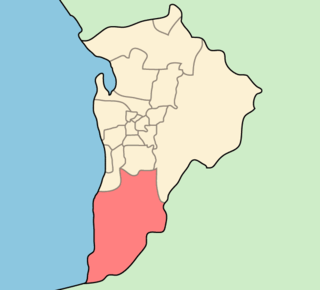Related Research Articles

The Division of Kingston is an Australian Electoral Division in South Australia covering the outer southern suburbs of Adelaide. The 171 km² seat stretches from Hallett Cove and O'Halloran Hill in the north to Maslin Beach in the south, including the suburbs of Aberfoyle Park, Christie Downs, Christies Beach, Flagstaff Hill, Hackham, Hallett Cove, Huntfield Heights, Lonsdale, Maslin Beach, Moana, Morphett Vale, Old Noarlunga, Onkaparinga Hills, Port Noarlunga, Reynella, Seaford, Sheidow Park, Port Willunga, Trott Park, Woodcroft, and parts of Happy Valley and McLaren Flat.

The City of Onkaparinga is a local government area (LGA) located on the southern fringe of Adelaide, South Australia. It is named after the Onkaparinga River, whose name comes from Ngangkiparinga, a Kaurna word meaning women's river. It is the largest LGA in South Australia, with a population of over 170,000 people in both urban and rural communities and is also geographically expansive, encompassing an area of 518.3 km². The council is headquartered in the Noarlunga Centre with area offices situated in Aberfoyle Park, Woodcroft and Willunga.

Seaford Rise is a metropolitan suburb of Adelaide, South Australia. It lies within the City of Onkaparinga. Its boundaries are formed by Griffiths Drive in the north, Commercial Road in the west, Main South Road in the east, and by an arbitrary border with Maslin Beach in the south.
Port Noarlunga South is a suburb in the Australian state of South Australia located in the Adelaide metropolitan area on the coastline of Gulf St Vincent about 30 kilometres south of the state capital of Adelaide.

Salisbury is a northern suburb in Adelaide, South Australia. It is the seat of the City of Salisbury, and in the South Australian Legislative Assembly electoral district of Ramsay and the Australian House of Representatives division of Spence. The suburb is a service area for the City of Salisbury district, with an abundance of parklands, shops, cafes and restaurants. Parabanks Shopping Centre is also located in Salisbury, which includes Woolworths, Coles and Big W as its signature retailers.
Yatala is a former electorate of the South Australian House of Assembly located within the cadastral Hundred of Yatala. It was one of the original Assembly districts in 1857, abolished in 1902.
The John Bice Memorial Oval is a public park in the Australian state of South Australia located within the suburb of Christies Beach and which is used by the Christies Beach Football Club and Southern District Cricket Club as their home ground.
Sturt was an electoral district of the House of Assembly in the Australian state of South Australia. It was named after the explorer Charles Sturt.
City of Adelaide was an electoral district of the South Australian House of Assembly, the lower house of the bicameral legislature of the then colony of South Australia.
Encounter Bay was an electoral district of the House of Assembly in the Australian colony of South Australia from 1857 to 1902.
Stanley was an electoral district of the House of Assembly in the Australian state of South Australia.
Baudin was an electoral district of the House of Assembly in the Australian state of South Australia from 1977 to 1993. It was in the southern suburbs of Adelaide. In 1977, the polling places were: Christie Downs, Christies Beach, Hackham, Hackham East, Hallett Cove, Moana, Noarlunga, O'Sullivan Beach, Port Noarlunga and Seaford.
Brighton was an electoral district of the House of Assembly in the Australian state of South Australia from 1970 to 1985. Brighton was replaced by the seat of Bright at the 1985 election.
East Adelaide was an electoral district of the South Australian Legislative Council from 1851 to 1857 and an electoral district of the South Australian House of Assembly from 1862 to 1902.
East Torrens was an electoral district of the House of Assembly in the Australian state of South Australia from 1857 to 1902 and again from 1915 to 1938.
The Burra was an electoral district of the House of Assembly in the Australian state of South Australia from 1862 to 1875.
The Burra and Clare was an electoral district of the House of Assembly in the Australian state of South Australia from 1857 to 1862.
The District Council of Willunga, was a local government area in South Australia seated at Willunga from 1853 until 1997.
The City of Happy Valley, formerly the District Council of Meadows, was a local government area in South Australia from 1935 until 1997.
Southern District was an electoral district for the Legislative Council of South Australia from 1882 until 1975. Prior to the passing of the Constitution Act Further Amendment Act 1881, the Legislative Council was 18 members elected by people from across the entire Province. From 1975, the Council returned to being elected from the entire state.
References
- ↑ "Statistical Record of the Legislature, 1836 - 2007" (PDF). Parliament of South Australia. Archived from the original (PDF) on 11 March 2019. Retrieved 19 January 2014.
- ↑ "The new counties, hundreds and district atlas of South Australia and Northern Territory 1876" (PDF). Government of South Australia. 1876. p. 29. Retrieved 15 February 2016.